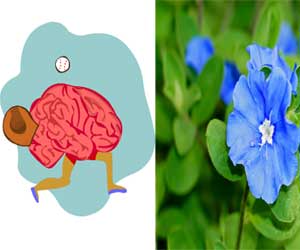- Home
- Editorial
- News
- Practice Guidelines
- Anesthesiology Guidelines
- Cancer Guidelines
- Cardiac Sciences Guidelines
- Critical Care Guidelines
- Dentistry Guidelines
- Dermatology Guidelines
- Diabetes and Endo Guidelines
- Diagnostics Guidelines
- ENT Guidelines
- Featured Practice Guidelines
- Gastroenterology Guidelines
- Geriatrics Guidelines
- Medicine Guidelines
- Nephrology Guidelines
- Neurosciences Guidelines
- Obs and Gynae Guidelines
- Ophthalmology Guidelines
- Orthopaedics Guidelines
- Paediatrics Guidelines
- Psychiatry Guidelines
- Pulmonology Guidelines
- Radiology Guidelines
- Surgery Guidelines
- Urology Guidelines
Ayurvedic herb Sankhaholi: A remarkable memory booster, finds study

Ayurvedic herb Evolvulus alsinoides Linn. traditionally known as Sankhaholi have a remarkable neuropharmacological effect and may be used as a memory booster, revealed a study appeared in the Journal of Ayurveda and Integrative Medicine. The study has found Sankhaholi as the best source of Shankhpushpi, a traditional ayurvedic drug widely used for its actions on the central nervous system, especially to improve intellect and boost memory.
There are mainly four varieties of herbs viz. Canscora decussata Schult. (CD), Clitorea ternatea Linn. (CT), Convolvulus pluricaulis Choisy. (CP) and Evolvulus alsinoides Linn. (EA) which are considered being the source of Shankhpushpi.
In this study, the authors have used methanol extracts of all four varieties of herb to evaluate the neupharmalogical effects of these varieties. The test was done both in-vitro and in-vivo. Experiments such as protection against β-amyloid-induced neurotoxicity on brain cell line (Neuro 2A), antioxidant potential, AchE (acetylcholinesterase enzyme) inhibition, and 5-LOX (lipoxygenase) enzyme inhibition were conducted for in vitro evaluation. For in vivo evaluation, scopolamine (0.3 mg/kg i.p.) induced memory retrieval using pole climbing apparatus and Morris water maze were performed in rat models.
Key findings
- It was found that protective effects of EA and CD against β-amyloid-induced neurotoxicity in Neuro 2A cells were significantly higher than CT and CP.
- EA proved to be superior to other varieties on the basis of antioxidant activity, AchE inhibitory and LOX inhibitory activities.
- The preventive activity of EA on scopolamine-induced memory retrieval in pole climbing and Morris water maze task in rats was found to be higher than that of CD, CT, and CP.
Based on the findings of the study the authors concluded that EA (Sankhaholi ) has remarkable neuropharmacological effect as compared to the other three varieties of Shankhpushpi.
The authors believe that this effect may be attributed due to the presence of steroids (stigmasterol and betulinic acid), coumarins (scopoletin) and flavonoids (β-carotene and chlorogenic acid). Hence it can be used as a promising lead in the development and management of neuronal disorders including Alzheimer's disease.
For further details, please click on the link
https://doi.org/10.1016/j.jaim.2017.08.012

Disclaimer: This site is primarily intended for healthcare professionals. Any content/information on this website does not replace the advice of medical and/or health professionals and should not be construed as medical/diagnostic advice/endorsement or prescription. Use of this site is subject to our terms of use, privacy policy, advertisement policy. © 2020 Minerva Medical Treatment Pvt Ltd